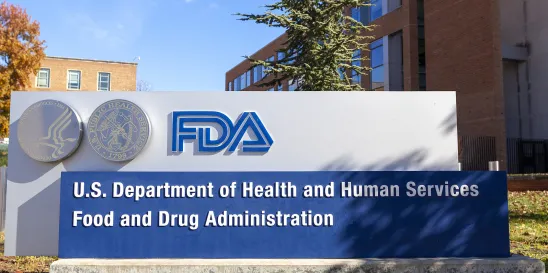Earlier this month, the Food and Drug Administration (“FDA” or “the Agency”) issued a highly anticipated proposed rule outlining the regulatory framework and implementation plan for Laboratory Developed Tests (“LDTs”).[1] The LDT regulatory status is long and meandering—and summarized below—but, critically for FDA, LDTs have historically been a medical product category for which FDA has exercised enforcement discretion.
Unsurprisingly, the proposed rule has already received significant pushback, with industry participants claiming that FDA’s interpretation of the Food, Drug, and Cosmetics Act (“FDCA”) is overly expansive and that the Agency does not, in fact, have the authority to regulate lab-developed diagnostic products. Although this argument is a common response to any FDA rule that purports to increase regulation, the argument might cut deeper, as the Supreme Court is set to hear a case challenging the long-established Chevron doctrine (the “Chevron Doctrine”) – a judicial policy under which executive agencies (e.g., FDA) are afforded deference in their interpretations of ambiguous legislation.
For FDA, though, this appears to be more about health and human safety than flexing its rulemaking power. LDTs have evolved in the nearly fifty years since they burst onto the scene, now used quite often in clinical decision-making and selection of therapeutic options for serious diseases. Congress could not get legislation through, and yet technology propels forward—technology that, according to FDA, “[has] a significant impact on public health.”[2]
1. The Proposed New Rule
a. Overview
On October 3, 2023, FDA issued a proposed rule that, once finalized, would (i) codify the Agency’s long-standing position that In Vitro Diagnostics (“IVDs”),[3] including LDTs are subject to regulation as “devices” under the FDCA, and (ii) phase-out FDA’s historical enforcement discretion with respect to LDTs.
b. Background
i. FDA’s Historical Regulatory Approach for LDTs
The regulatory framework for medical devices was established under the Medical Device Amendments of 1976, and FDA has long interpreted the statutory definition of “device”[4] to include IVDs. Although LDTs are a subset of IVDs, technically making them a device subject to FDA regulation under FDA’s interpretation, FDA has historically implemented a policy of so-called “enforcement discretion” for LDTs because, at the time of the device amendments nearly fifty years ago, FDA considered LDTs simple tests that posed little risk to patient safety – they were made and intended for use in a single clinical laboratory for a small volume of patients. Because of FDA’s policy of enforcement discretion, LDT manufacturers have not been required to comply with registration requirements, premarket review, “Quality System” regulation, and other regulatory requirements applicable to regulated devices. However, despite the official policy of enforcement discretion, FDA has always made clear that it maintains the authority to regulate LDTs and intends to do so when such products pose a threat to public health and safety.
Over the past decade, as clinical laboratories and diagnostic testing have become more sophisticated, FDA has expressed its intent to begin regulating LDTs, giving significant focus to certain categories of LDTs that it deems high-risk (e.g., direct-to-consumer LDTs). In 2014, FDA issued a draft guidance that would have established a regulatory framework for LDTs, including a phase-out of its enforcement discretion policy.[5] However, the guidance was never finalized due, in large part, to concern from laboratories and other industry participants over FDA’s authority to implement such a framework. In 2017, FDA issued a Discussion Paper on LDT Policymaking, notably stating that the Agency would not be finalizing its 2014 draft guidance, in order to allow Congress time to “develop a legislative solution.”[6] In the discussion paper, FDA again asserted its position that LDTs fall within FDA’s regulatory authority but requested that Congress clarify the scope of FDA authority with respect to LDTs. After years of discussions over potential regulatory approaches for LDTs between FDA and the industry, all eyes were on Congress for a final solution.
ii. Legislative Efforts
The first legislative proposal to overhaul the diagnostic testing space was the Diagnostic Accuracy and Innovation Act (DAIA), which was issued as a discussion draft in 2017 but did not gain much traction.[7] Subsequently, the Verifying Leading Edge IVCT Development (VALID) Act was introduced and ultimately considered as part of the Senate proposals for the new user fee reauthorization in 2022.[8] This legislation would have adopted a new category of FDA-regulated products, called In Vitro Clinical Tests (IVCTs), which would encompass both IVDs, generally, and LDTs, specifically. Under the legislation, FDA would have been required to establish new regulatory frameworks specifically for IVCTs. However, the legislation was ultimately not passed.
Although FDA has been clear that its preferred approach for regulating diagnostic products, specifically LDTs, would be to act according to a Congressionally-developed statutory framework, FDA has also been clear that action is needed to ensure patient safety in the face of increasingly sophisticated, and increasingly underperforming, LDTs. Therefore, FDA has taken administrative action through the proposed new rule.[9]
c. Key Provisions of the Proposed Rule
The proposed rule, if finalized, would do two important things – (1) amend the regulatory definition of “IVD Products” and (2) phase out FDA’s policy of enforcement discretion for LDTs.
i. Redefining “IVD”
The first notable piece of FDA’s proposed new rule is the amendment to the regulatory definition of IVD, which would add the following clause to the second sentence of the regulatory definition as follows: “These products are devices as defined in section 201(h) of the Federal Food, Drug, and Cosmetic Act (the act), and may also be biological products subject to section 351 of the Public Health Service Act, including when the manufacturer of these products is a laboratory” (emphasis added). FDA has long held the position that all IVDs (including LDTs) are devices under the FDCA but the proposed amendment would codify this interpretation in the form of a more permanent regulation.
ii. Phasing Out Enforcement Direction for IVDs
Importantly, the proposed rule, if finalized, would also introduce a phased approach to ending FDA’s policy of enforcement discretion for LDTs. The phased approach would establish timelines for LDT sponsors to comply with different categories of FDA device regulations, and the clock would start with the publication of the final rule, which would confirm the final phase-out policy, and be the date to which all five phases would be anchored. The proposed phases are as follows:
- Stage 1: LDTs are subject to Medical Device Reporting (MDR),[10] as well as adverse event reporting,[11] one year after publication of the final rule;
- Stage 2: LDTs are subject to registration/listing,[12] labeling,[13] and investigational use[14] requirements two years after publication of the final rule;
- Stage 3: LDTS are subject to Quality System Regulations (QSR)[15] three years after publication of the final rule;
- Stage 4: High-risk LDTS are subject to premarket review[16] three-and-a-half years after publication of the final rule; and
- Stage 5: Mid- and low-risk LDTs are subject to premarket review[17] four years after publication of the final rule.
iii. Request for Comments on Potential Exclusions
The proposed rule includes several specific requests for comments, which focus primarily on potential exceptions to the phaseout policy (i.e., areas in which FDA should continue to exercise enforcement discretion). Although the proposed rule does not provide a specific stance on the following topics, it opens the door for a dialogue between FDA and the industry, signaling that the Agency may be open to continuing its policy of enforcement discretion in one or more of these areas, as long as the policy can be structured in a way that does not jeopardize patient safety: (a) “grandfathering” in (i.e., continuing a policy of enforcement discretion with respect to premarket review and Quality System requirements for) currently marketed LDTs; (b) exclusions for Academic Medical Centers (“AMCs”); and (c) coordinating with other state- and federal-level accreditation and oversight programs.
2. The Pending Supreme Court Case
Last fall, the Supreme Court agreed to hear the case, Loper Bright Enterprises v. Raimondo, on the issue of whether to uphold the nearly forty-year-old Chevron Doctrine.[18]
The Chevron Doctrine originates from the 1984 Supreme Court case, Chevron v. Natural Resources Defense Council, which held that courts should defer to a federal agency’s interpretation of an ambiguous statute as long as that interpretation is reasonable.[19] Chevron established a highly deferential framework for courts reviewing agency interpretations of statutes that are susceptible to multiple interpretations, which asks, first, whether the statute is, indeed, ambiguous and, second, whether the agency’s interpretation is, indeed, reasonable. In Chevron, the Court cited agency expertise as a primary rationale for affording deference to agency interpretations in ambiguous contexts – that is, agencies, which are comprised of experienced and knowledgeable subject matter experts, are in a more informed position to determine subject matter issues than judges, who may solicit input from subject matters experts, but are not, themselves, subject matter experts. This rationale is especially applicable in the realm of FDA regulation, where an understanding of the proper regulatory framework relies on a nuanced mastery of numerous scientific variables that inform the safety and effectiveness, as well as associated risks, of a regulated product.
The Loper case comes to the Supreme Court on appeal from a D.C. Circuit decision that relied on the Chevron Doctrine to uphold a National Marine Fisheries Service (“NMFS”) rule that would require commercial fishermen to bear the costs of compliance monitoring devices.[20] Last November, a group of herring fishermen appealed the decision, asking the Supreme Court to rule on both (i) their challenge to the NMFS’s proposed rule and (ii) the viability of the Chevron Doctrine. After five rounds of internal conferences, the Supreme Court agreed to hear the case on the Chevron Doctrine issue only. Specifically, the Court agreed to decide “whether the Court should overrule Chevron or at least clarify that statutory silence concerning controversial powers expressly but narrowly granted elsewhere in the statute does not constitute an ambiguity requiring deference to the agency.” The Loper case is scheduled for argument during the Court’s October 2023-2024 term, so the issuance of the Supreme Court’s decision on the fate of the Chevron Doctrine could coincide with FDA’s issuance of the final rule on LDT regulation.
3. The Intersection of Congressional Inaction and Executive, Judicial Initiatives
In the proposed rule, FDA spends a full fifteen pages justifying its initiative to clarify the regulatory ambiguity surrounding LDTs, which appears to be largely driven by the slew of safety and efficacy concerns that arose out of the COVID-19 pandemic, when FDA was unable to regulate products in its usual manner. As more and more reports of dangerously underperforming LDTs come to light, LDT instrumentation and software become increasingly complex, and LDTs are more commonly being used to inform clinical decision-making, as well as to screen, predict, diagnose, and even recommend treatment options for serious diseases, a perfect storm is brewing that poses a real threat to patient safety and, in the eyes of FDA and supporters of the proposed rule, calls for a timely correction of this significant regulatory blind spot.
Despite the valid rationale behind FDA’s focus on increasing LDT regulation, legal challenges to the final rule are expected, as industry participants have already been publicly critical of the proposed regulatory scheme, many arguing that the Agency has interpreted the FDCA in a manner that exceeds the authority that the statute actually grants. For example, the American Clinical Laboratory Association (“ACLA”) voiced its opposition to the proposed rule before the rule was even published in the Federal Register, stating that “ACLA has long taken the position that FDA does not have statutory authority to regulate LDTs under its medical device authority and strongly opposes unilateral action that exceeds the Agency’s current authority.”[21]
Based on the potentially parallel timing of the Loper decision and the issuance of FDA’s final LDT rule, there is a chance that a reviewing court could choose to make an example out of a subsequent challenge to FDA’s LDT rule if it is preceded by the overturn of the Chevron Doctrine. Although the Chevron Doctrine has served as the legal standard for thousands of administrative law cases spanning nearly four decades, the current Supreme Court may be in a position to significantly narrow, if not completely overturn, the doctrine, as it is composed of jurists with a history of standing against the Chevron doctrine.[22]
In the meantime, manufacturers of LDT products should prepare for compliance with the impending final rule by prioritizing compliance initiatives based on the staged approach established in the proposed rule, beginning with Stage 1 reporting requirements. Manufacturers of LDT products that involve complex and/or automated software and LDT products that test for serious diseases, such as cancer and heart disease, should be especially vigilant, as they may be the target of initial enforcement actions following FDA’s final rule. At the same time, these manufacturers can submit comments through December 4, 2023,[23] and should consider tuning in to FDA’s Webinar on the proposed rule on October 31, 2023.[24] Finally, manufacturers should remain aware of the significant shift in the regulatory landscape that could result if the Supreme Court reverses the landmark Chevron case.
FOOTNOTES
[1] Although the FDCA does not define the term, FDA defined LDT in the proposed rule as “an IVD that is intended for clinical use and that is designed, manufactured, and used within a single laboratory that is certified under the Clinical Laboratory Improvement Amendments of 1988 (CLIA) to perform high-complexity testing (i.e., is a CLIA-certified high complexity lab).” 88 Fed. Reg. 68009.
[2] See Press Release, FDA Proposes Rule Aimed at Helping to Ensure Safety and Effectiveness of Laboratory Developed Tests, U.S. Food & Drug. Admin. (Sept. 29, 2023).
[3] IVD is defined as “reagents, instruments, and systems intended for use in the diagnosis of disease or other conditions, including a determination of the state of health, in order to cure, mitigate, treat, or prevent disease or its sequalae, and intended for use in the collection, preparation, and examination of specimens taken from the human body. These products are devices as defined in section 201(h) of the Federal Food, Drug, and Cosmetic Act (the act), and may also be biological products subject to section 351 of the Public Health Service Act.” 21 C.F.R. § 809.3(a).
[4] Device is defined as “an instrument, apparatus, implement, machine, contrivance, implant, in vitro reagent, or other similar or related article, including any component, part, or accessory which is … intended for use in the diagnosis of disease or other conditions, or in the cure, mitigation, treatment, or prevention of disease.” 21 U.S.C.A. § 321(h)(1).
[5] See Draft Guidance, Framework for Regulatory Oversight of Laboratory Developed Tests (LDTs), U.S. Food & Drug Administration (Oct. 3, 2014).
[6] See Discussion Paper on Laboratory Developed Tests (LDTs), U.S. Food & Drug Administration (Jan. 13, 2017).
[7] See Press Release, Dr. Bucshon, DeGette Release Draft of the Diagnostic Accuracy and Innovation Act (DAIA) (Mar. 21, 2017).
[8] See U.S. Congress, House, Verifying Accurate Leading-edge IVCT Development (VALID) Act of 2021, HR 4128, 117th Cong., 1st sess., introduced in House June 24, 2021.
[9] See Press Release supra FN 2.
[10] See 21 CFR Part 803.
[11] See 21 CFR Part 806.
[12] See 21 CFR Part 807.
[13] See 21 CFR Parts 801 and 809, Subpart B.
[14] See 21 CFR Part 812.
[15] See Current Good Manufacturing Practices (“CGMP”) rules at 21 CFR Part 820.
[16] See the Pre-Market Application (“PMA”) process at 21 CFR Part 814.
[17] See the 510(k) process at 21 CFR Part 807, Subpart E, and/or the de novo request process at 21 CFR Part 860, Subpart D.
[18] See Loper Bright Enterprises v. Raimondo, Docket No. 22-451.
[19] See Chevron v. Natural Resources Defense Council, 467 U.S. 837 (1984).
[20] The Chevron Doctrine was invoked because the governing statute does not make clear whether the cost of the compliance monitoring device should be paid by the regulated party or by the industry, so the rule was a product of agency interpretation.
[21] See ACLA Opposes Unilateral FDA Action to Regulate Laboratory Developed Tests under Medical Device Authority, ACLA (Sept. 29, 2023).
[22] See, e.g., Cuozzo Speed Techs., LLC v. Lee, 579 U.S. 261 (2016); Buffington v. McDonough, 143 S. Ct. 14 (2022).
[23] The rule has its own email address and comments can be sent to LDTproposedrule@fda.hhs.gov.
[24] See Webinar – Proposed Rule: Medical Devices; Laboratory Developed Tests, U.S. Food & Drug Admin. (Oct. 16, 2023).




 />i
/>i

